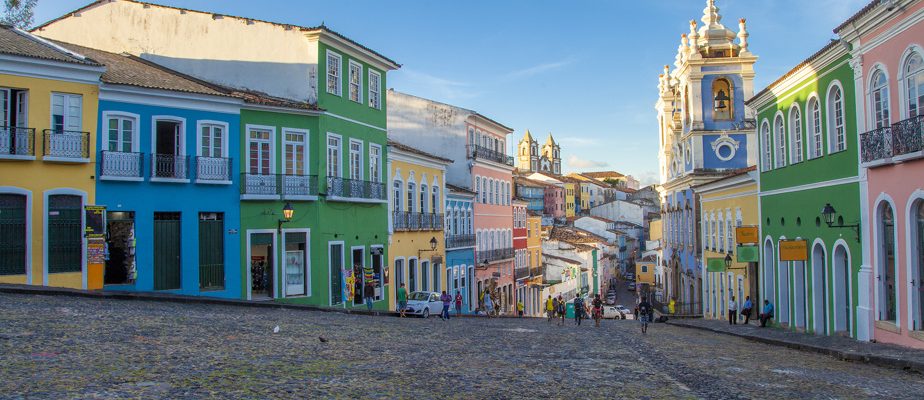When we think of the big cities of Brazil, there is obviously São Paulo the megalopolis, Rio the enchanting city or Brasilia the capital. But for some reason, Salvador is often forgotten. After spending a few days there, the mystery remains. Because the city is well worth the trip.
First point before going any further: we are obviously talking about Salvador de Bahia, the largest municipality in the Brazilian Northeast, and not El Salvador, this small Central American nation which borders the Pacific Ocean. We wanted to underline this “detail”, because since our return, each time we recount our trip, we sense extreme confusion in our interlocutor as soon as we mention the word that begins with S. (“What? You are went to El Salvador too?”)
Second point: a little history lesson. Salvador de Bahia was the first capital of Brazil, from 1549 to 1763. A convergence point of European, African and indigenous cultures, this city is also known for having welcomed the first African slaves bound for sugar cane plantations.

PHOTO NATALIA SCHUCHARDT, GETTY IMAGES
The Igreja e Convento São Francisco, recognized as one of the most beautiful churches in Brazil
This multicultural heritage is particularly apparent when visiting its historic center. Perched 85 meters above sea level, the place is located at the top of an escarpment that can be climbed on foot (for those who are not afraid of being hot), by car (for those who are not afraid of narrow two-way streets) or by elevator (for those who are not afraid of constructions from the 19the century).
You can feel the mixed and multicultural Brazil in different ways: to the sound of batucada players (traditional percussion) while enjoying a Moqueca (fish stew) on a terrace, admiring the vibrantly colored canvases of the numerous art shops, by accepting the iridescent ribbons (fitas do Bonfim) offered by the inhabitants (for a fee, of course), by catching a capoeira demonstration, or even by contemplating the multiple representations (images, sculptures, etc.) of the Baianas de l’Acarajé , these black women selling sweets, who can be found almost everywhere.
Contrasts

PHOTO STEFAN WIESER, GETTY IMAGES
Colorful facades in the historic district of Pelourhino
Listed as a UNESCO World Heritage Site in 1985, one of Salvador’s neighborhoods, Pelourhino, located in the heart of the historic center, is stunning with its brightly colored colonial buildings that make any photo look like a map postal. There are churches, museums, souvenir shops, and a highly Instagrammable slanted, triangular public square called Largo de Pelourhino. Her great beauty contrasts with her dark past; slaves were exposed and flogged there.

PHOTO MARC-ANDRÉ LEMIEUX, THE PRESS
The lower town of Salvador, seen from the historic center
Detail to note: Michael Jackson visited the site in 1996 to shoot the music video for They Don’t Care About Us, directed by Spike Lee. The balcony scene is also immortalized by means of a poster which adorns the facade of a house, which is difficult to miss.
The Pelourhino can be visited in the middle of the day, under the blazing sun, because once the sun sets, the atmosphere changes radically. The smaller streets quickly become deserted, and during the evening we were there, police cars could be seen on every street corner. We didn’t witness any untoward events, but let’s say that such a strong police presence leaves a strange aftertaste.
Range of beaches

PHOTO RODRIGO SCHMIEGELOW, GETTY IMAGES
The magnificent Itapuã beach, 25 km from the city center
But Salvador is not just an ultra-photogenic historic center. It also has a wide range of beaches. The most urban is certainly Praia Porto da Barra, a small stretch of coastline that is particularly crowded on weekends. It has an impressive number of umbrellas per square foot. Regulars bring their speakers, which spit out their decibels all day long. Friendly advice: ask the price when a seller offers you a caipirinha. Because when it comes time to pay the bill, at the end of the afternoon, you might be surprised by the amount charged…
-

PHOTO MARC-ANDRÉ LEMIEUX, THE PRESS
Flamengo beach
-

PHOTO MARC-ANDRÉ LEMIEUX, THE PRESS
Itapua beach
1/2
In contrast, 33 kilometers from the city center (around forty minutes by car, depending on congestion), we love the calm of Flamengo, a beach surrounded by greenery on which you recharge your batteries. And between the two, we retain the beaches of Piatã and Itapuã, a sort of compromise 25 kilometers away.
Salvador, which has almost 3 million inhabitants, is also the starting point for several excursions in the state of Bahia. In the south, one of the most popular is the getaway to Morro de São Paulo, a very touristy village located on an island where all travel is done by walking, since no cars circulate there. After visiting it in one day, which involves leaving the hotel at 5:30 a.m., a total of seven hours of travel (taxi, ferry, bus and jet boat), as well as a return, completely exhausted, around 7 p.m., we recommend sleeping there for one or two nights.
Practical information
The city of Salvador is easy to access, since it contains the main airport of the state of Bahia, which is located at the end of an avenue which crosses a grove of bamboos. Air connections to Rio and São Paulo (lasting around two hours) are frequent, although more expensive than other internal flights to other South American countries, such as Colombia and Argentina.
For example, our Rio-Salvador ticket cost $240 CAN. But since while waiting for our suitcases at the baggage carousel, we almost ran into former Brazilian president Jair Bolsonaro, whom a particularly noisy welcoming committee was waiting for on the other side of the exit doors, we decided to leave. Said it was part of the package!
